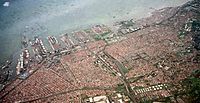Port of Tanjung Priok
| Port of Tanjung Priok | |
|---|---|

Aerial view
|
|
| Location | |
| Country |
|
| Location | Tanjung Priok, North Jakarta |
| Coordinates | 6°06′14″S 106°53′11″E / 6.104°S 106.8865°ECoordinates: 6°06′14″S 106°53′11″E / 6.104°S 106.8865°E |
| Details | |
| Owned by | PT Pelabuhan Indonesia II |
| Type of harbor | Natural |
| Size of harbor | 604 ha (6.04 sq km) |
| Land area | 424 ha (4.24 sq km) |
| Size | 1,028 ha (10.28 sq km) |
| Available berths | 76 |
| Statistics | |
| Annual container volume | 6.59 million TEU's (2013) |
|
Website www |
|
The Port of Tanjung Priok is the busiest and most advanced Indonesian seaport, handling more than 50% of Indonesia's trans-shipment cargo traffic. The port is located at Tanjung Priok, North Jakarta, which is operated by Indonesian state owned PT Pelindo II. Container terminal of the port is known as Jakarta International Container Terminal (JICT), which is operated by the Hutchison Port Holdings and Pelindo II is the largest container terminal in Indonesia and the country's national hub port. In April 2011, JICT received an Asian Freight and Supply Chain Award (AFSCA) as the best service quality and technology innovation of terminal with less than 4 million twenty-foot equivalent units handling capacity.
The earliest record mentioning this area as a capital city can be traced to the Indianized kingdom of Tarumanagara as early as the fourth century. In AD 39, King Purnawarman established Sunda Pura as a new capital city for the kingdom, located at the northern coast of Java. Purnawarman left seven memorial stones with inscriptions bearing his name spread across the area, including the present-day Banten and West Java provinces. The Tugu Inscription is considered the oldest of all of them.
After the power of Tarumanagara declined, all of its many territories, including Sunda Pura, became part of the Kingdom of Sunda. The harbour area were renamed Sunda Kelapa as written in a Hindu monk's lontar manuscripts, which are now located at the Bodleian Library of Oxford University in England, and travel records by Prince Bujangga Manik. By the 14th century, Sunda Kelapa became a major trading port for the kingdom. The first European fleet, four Portuguese ships from Malacca, arrived in 1513 when the Portuguese were looking for a route for spices, especially black pepper.
...
Wikipedia
